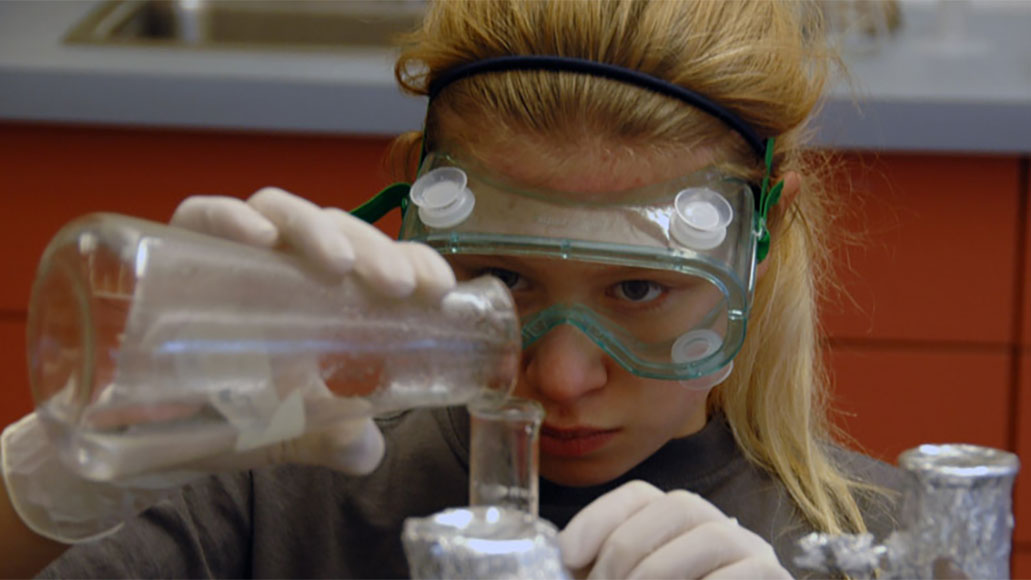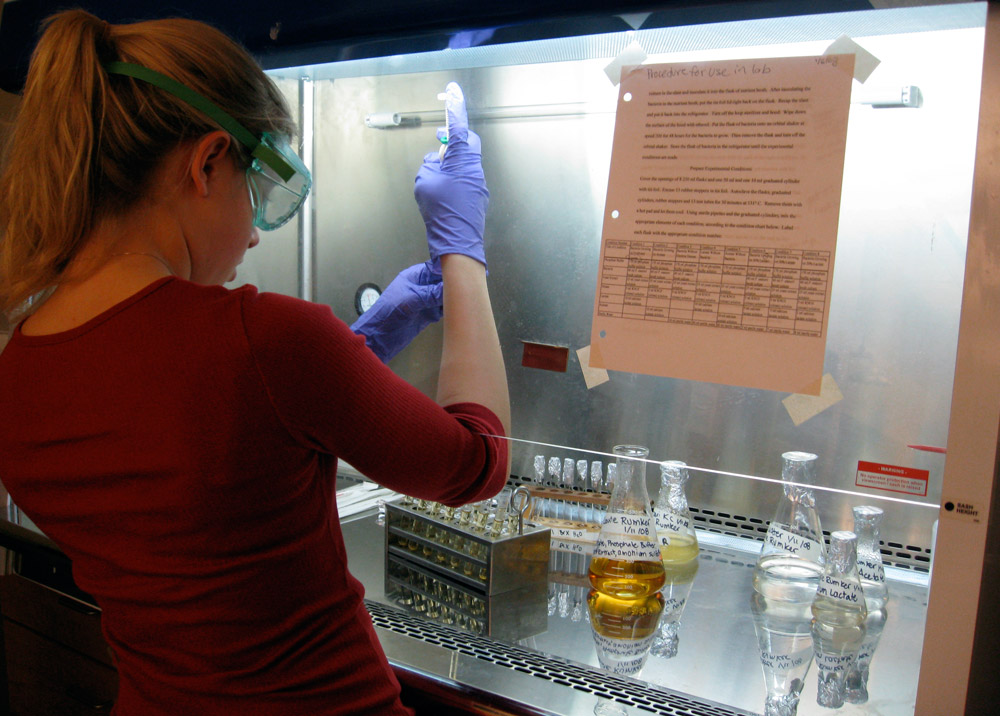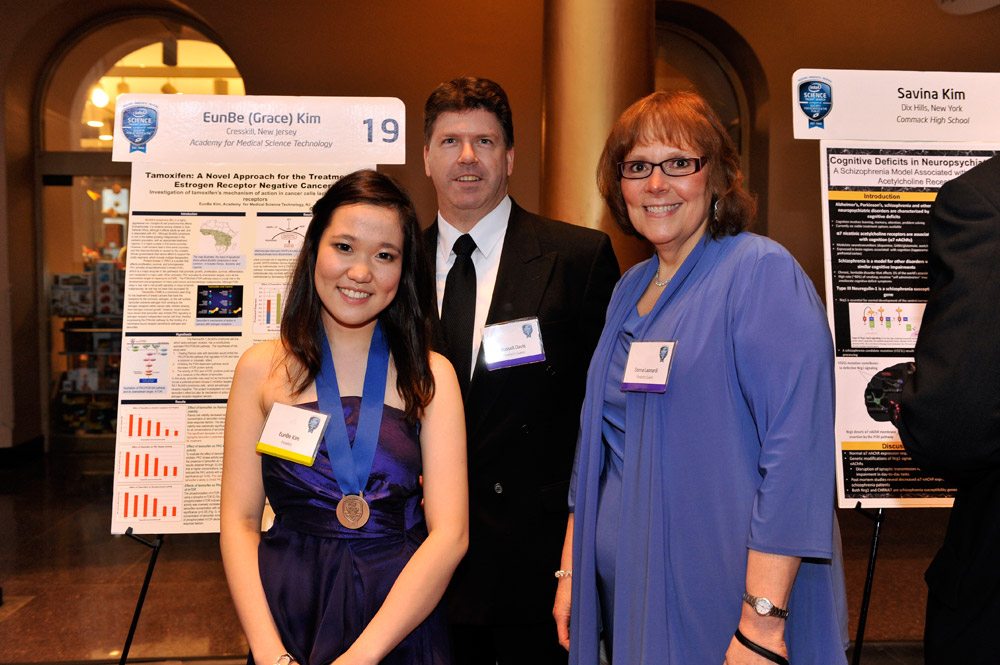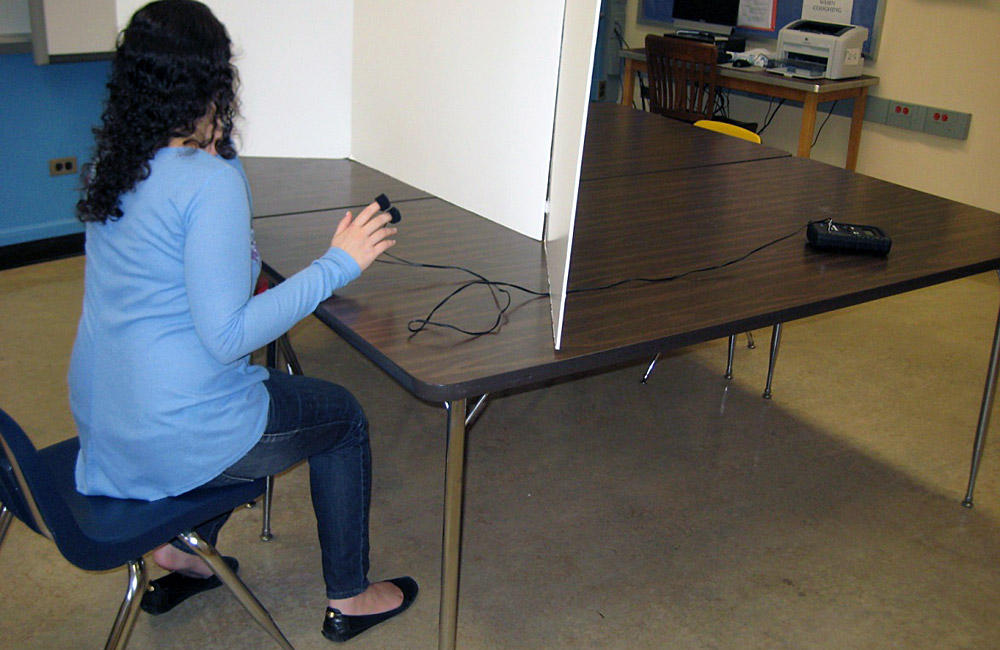Pathways to research: Pursuing a passion
Young scientists get creative with their after-school work

Laurie Rumker prepares the solutions she will use to grow her bacteria.
Laurie Rumker
While hanging out with friends, Michelle Hackman noticed that many of them texted each other instead of just chatting amongst themselves. That made her curious: Might cell phones be affecting our social interactions — and maybe even our brains?
Before long, the teen was searching for studies that had probed the impact of cell phone use on behavior. She didn’t find any. But she did turn up an industry report saying that more than half of Americans feel nervous when they don’t have access to their cell phones. The researchers referred to this as “disconnect anxiety.” When Hackman learned it was not something psychologists had begun to study, she realized it might make a great science fair project.
Working with Alan Schorn, her science teacher at Great Neck North High School in New York, Hackman sorted through a number of possible research questions. Unfortunately, they all seemed too complicated. So she decided to focus on something simple — something she could easily test: Does disconnect anxiety really exist?
The teen considered searching out a university research lab where she could pursue her independent research. It’s an approach many of her classmates had opted for: Working with a scientist doing related research.
But in the end, she chose to work at her high school. “Why hunt around for a lab and tack on [my study] to someone else’s research?” she asked. Going it alone offered greater freedom. With no one to answer to but herself, she would have total control over how she investigated the issue and analyzed her findings.
“Garage” projects like this — those undertaken at school or home — require originality and independence. For many students looking for a chance to get creative, such projects are a good way to go, says mathematician Dave Marker. He says they “give the student a real chance to demonstrate originality. That is much harder when doing a project in an established lab.”
A mathematician at the University of Illinois at Chicago, Marker should know. For the past 12 years, he’s been a judge for the Intel Science Talent Search, a premier research competition for high school students. It was developed and run by Society for Science & the Public (which publishes Science News for Kids).
Overcoming obstacles
Hackman recruited 150 students to participate in her study. One at a time, students sat in a classroom with white walls, no windows and nothing to look at or do. Half could keep — and use — their cell phones during the study. The rest had to leave their phones outside the room. Before, during and after each trial, the study measured each participant’s level of anxiety.
Collecting all of those data wasn’t easy. To manage, Hackman needed to recruit and train a team of assistants. Every now and then, one of them failed to show up. Suddenly, Hackman was off scrambling to find a backup to run that day’s trials.
Even getting an empty room for the research frequently presented challenges. Every afternoon, it seemed like, “I’d have to kick people out,” she said.
But she finished. And in the end, Hackman discovered that, at least at her school, the students didn’t feel anxious when their phones were taken away. They were simply bored — sometimes enough to fall asleep! It wasn’t the result she expected, but it nabbed her second place in the 2011 Intel STS.
Schools vary in the resources they have available for student projects, but a bit of creativity and resourcefulness can go a long way. When she needed an isolation chamber, of sorts, Hackman merely corralled an empty classroom. It didn’t cost her or the school anything.
She tells of another Intel STS finalist who had even less to work with: When he needed a place to set up lab dishes to grow batches of cells, he commandeered a closet. If you listened to a description of his project, “It sounds like it was really professionally done,” Hackman says. But it was just a supply closet — “the only room his high school had.”
Sometimes a classroom countertop is all it takes. That’s where middle school student Laurie Rumker initially found space to set up her flasks to grow bacteria at Oregon Episcopal School in Portland. It wasn’t until high school that she decided to move her work into the school’s project laboratory, a dedicated space for independent research.

From those humble beginnings, the teen launched a developing career in chemistry. It really got a boost in her second year of high school. That’s when Hap Pritchard, a semiretired biochemistry professor who acted as her mentor, introduced the teen to “organoclay.” This specially treated clay helps hold onto pollutants while soil bacteria break them down. Cleanup crews at a nearby Superfund site — a location polluted with hazardous waste — had applied some of this special clay to aid in the cleanup there.
As Rumker started reading about the product, she recalls getting a little skeptical about how it would hold up over time. She suspected that bacteria might break down that part of the product that locks onto pollutants and prevents them from washing away. So she set out to test the clay’s longevity in the presence of soil bacteria.
Pritchard helped the young scientist refine her research questions. He also provided feedback on how she planned to test the clay by using equipment in the school lab. Such interactions between students and mentors are important, according to Bill Lamb, former chairman of Oregon Episcopal School’s science department. He recommends that all students “should try to find an adviser to consult with, if only to bounce ideas off of.”
Pritchard also helped boost Rumker’s spirits when things didn’t go as planned. For instance, the teen initially dissolved dye into a solution containing ethyl acetate, the same compound found in nail polish remover. Then she added a cubic centimeter of the gray, sand-textured organoclay. The part of the clay that holds onto pollutants glommed onto the dye, turning the clay pink. She figured that if the bacteria started breaking down that part of the clay, the dye would be released.
Then she added the bacteria.
She checked — and rechecked — her samples, but nothing happened. Despite the discouraging results, Rumker decided to stick with the project. Clearly, however, something would have to change.
So she altered the testing. She eliminated the clay, testing only that part of the product that binds to the pollutants.
Rumker ran her experiment again. And this time she tested several different concentrations of the pollutant-binding substance that she thought the bacteria would dine on.
High concentrations of the substance proved toxic: All the bacteria died. But in diluted samples, all of the microbes survived. By the end of her experiment, she had bacterial colonies that were actually thriving. Since they had no other food source, that meant they had to be eating part of the organoclay product.
Her findings suggest that organoclay does do its job, at least for a while. But as it breaks down, bacteria eat it up the same way they dine on the pollutants this product was supposed to be locking in place. Rumker’s findings landed her a spot as a finalist in the 2011 Intel STS. She is now 19 and a student at Stanford University.
Fully equipped
Some high schools, such as the Academy for Medical Science Technology in Hackensack, N.J., have no shortage of lab space available for student research projects.
“Students are not required to participate in the independent research program,” says EunBe (Grace) Kim, a former student at the Academy (and now a freshman at Harvard). But as a high school sophomore, this young scientist did use her school’s resources — to tackle cancer.
Her grandmother had been taking tamoxifen, a drug used to treat breast cancer. The medicine works by locking onto that part of the cancer cell that responds to the hormone estrogen. Without estrogen, these cancer cells stop growing. So if this drug can attach to the cell and block it from binding to estrogen, it can slow the cancer’s growth.
After studying information about the drug, Kim began to ponder whether it might also work against other cancers, including types that don’t need estrogen to grow.

Kim approached her biology teacher, Donna Leonardi, who agreed to mentor her. First puzzle: Which new cancer should she try the drug against? “My first choice was melanoma, a skin cancer,” Kim says. But she quickly discovered other researchers had already tested tamoxifen’s use against this deadly cancer. So she read some more — lots more — and one afternoon found a good candidate: Burkitt’s lymphoma. This fast-growing cancer can affect many organs in the body.
Although the disease is rare in the United States, it is the most common cancer among children in Africa. Kim’s research indicated that no one had yet tested the drug against this cancer. Even better, tamoxifen appeared to offer far fewer serious side effects than the current medicine used to treat this disease. So she ran the idea by her mentor and soon set to work.
Leonardi helped Kim order the supplies she needed, including batches of living lymphoma cells. She also taught Kim how to use unfamiliar equipment, like the microplate reader she used to count cancer cells before and after treating them with tamoxifen.
It took time, but Kim eventually became comfortable in the lab. As she did, she relied less on Leonardi for training and more on her as a sounding board to discuss ideas. And of course, the mentor provided plenty of encouragement.
“At times, conducting my independent research was frustrating and difficult,” acknowledges Kim. But the teen’s persistence won her a spot as a finalist at the 2012 Intel STS. “Without [Leonardi’s] support and encouragement,” Kim says, “my achievements would not have been possible.”
No matter what happens …
Working at school can present many challenges. For Kim, the biggest was time management. “I hardly had more than an hour to work on the project each day since I had to run to classes right after.”
Sharing equipment and lab — or classroom — space with other students can also present problems. Hackman had to chase other students out of her experimental rooms, but it was a price she willingly paid to have complete control over her research.

Complications, less-than-ideal experimental setups and surprising data are all part of doing science. What matters is how you deal with the setbacks you encounter. “Pick something that you’re really interested in and stick with it,” Rumker advises future researchers — “no matter what happens.”
That passion will show when it comes time to present your findings at a science fair. Often the most impressive projects, says Marker, the Intel STS judge, “are ones where the student’s passion started years before the Science Talent Search submission — and they have never stopped working on variations and improvements.”
“Figure out ways of getting around [obstacles],” recommends Rumker, “like using other methods or looking at the problem in a different way.”
And remember that when the tests aren’t successful, that doesn’t necessarily spell disaster. “[T]here have been projects that we rated highly although they were, in a real sense, failures,” says Carol Wood, a 20-year member of the Intel STS judging panel. She and her fellow judges ended up liking these projects anyway, she says, because a student learned from them. Sometimes, the teen researchers even took away insights that set them on new and interesting follow-up projects.
If your school isn’t set up for independent research, you can still figure out a way to make your project work. “Don’t get discouraged,” says Hackman. If there isn’t a research lab nearby, “you can always create your own.”
Sometimes all you need is a supply closet.